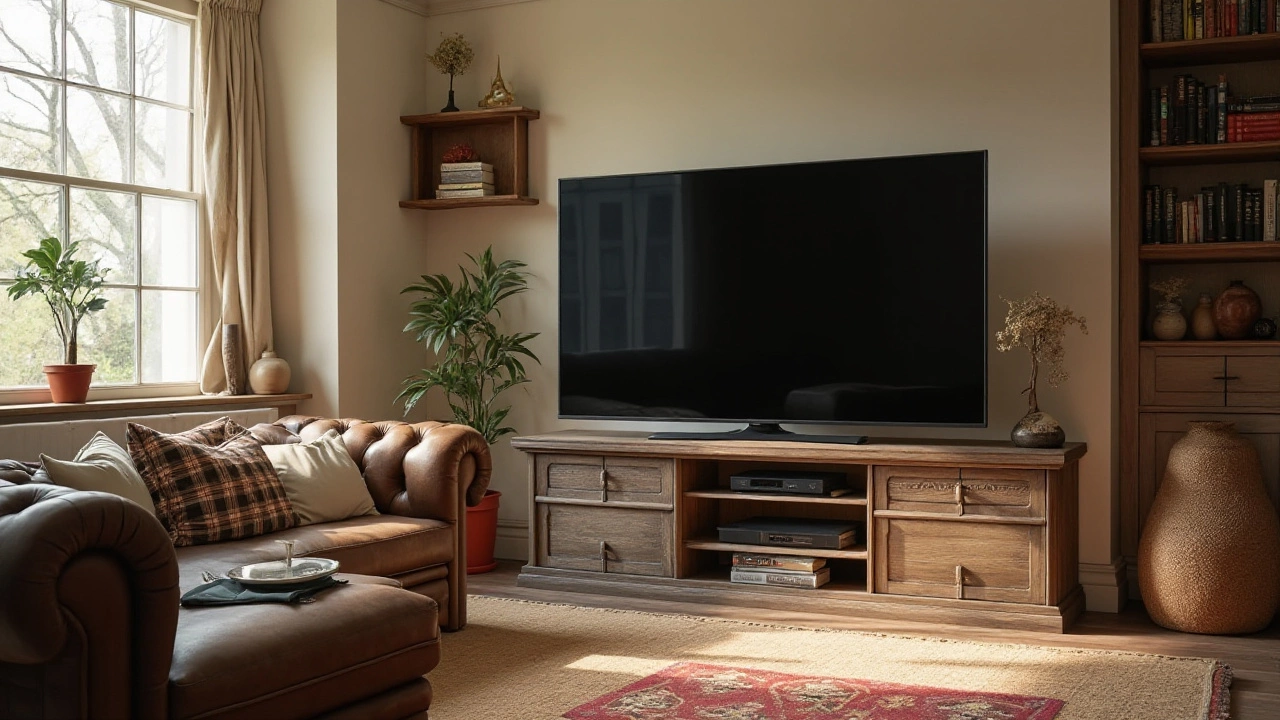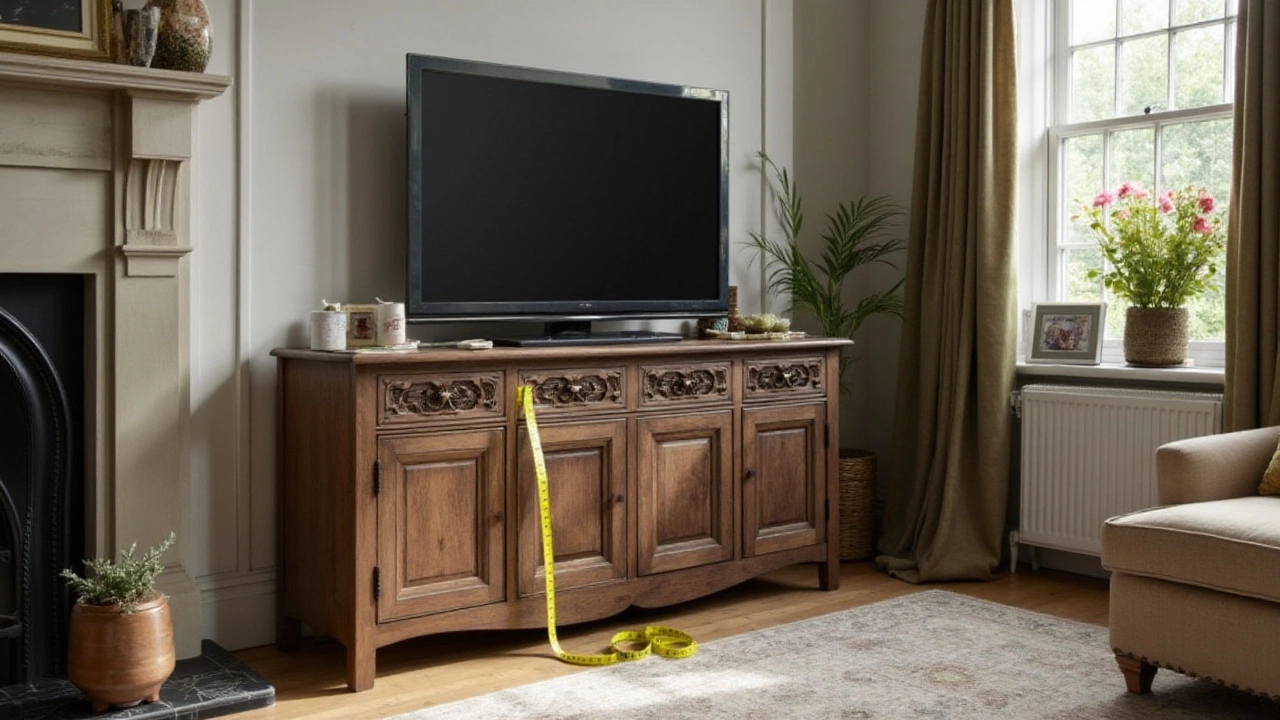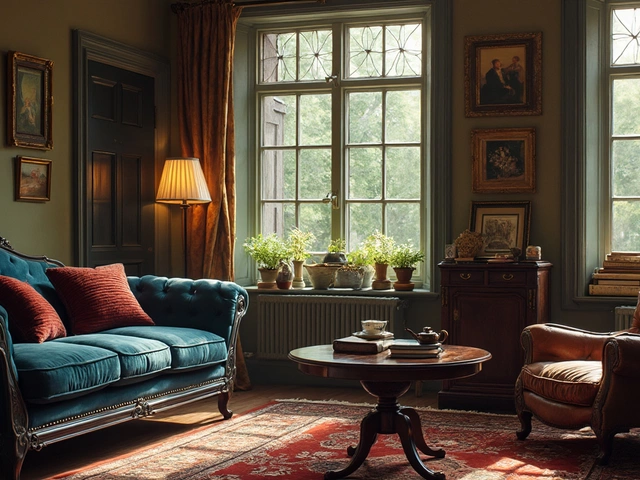 16
Jan,2025
16
Jan,2025
When you unbox a stunning 65 inch television, it's not just about the quality of the picture or the sleekness of the screen. You have to think about where it will reside. One of the simplest yet surprisingly complex considerations is the distance between the legs. Yes, those sturdy supports that prevent your entertainment centerpiece from taking a tumble.
The leg span on a 65 inch TV typically ranges from 40 to 45 inches apart, though this can vary depending on the brand and model. These numbers are crucial when you're trying to match your television with a fitting stand or piece of furniture. If you're indulging in a TV as large as 65 inches, it's worth putting a bit of thought into the support system underneath. After all, the stability of your setup can save you from unpleasant rearrangements—or worse, an accidental misstep.
- Introduction to TV Leg Measurements
- Importance of Accurate Measurements
- Types of TV Stands for a 65 Inch TV
- Room Arrangement and Space Considerations
- Tips for Selecting the Right Stand
- Stylish and Functional Setup Ideas
Introduction to TV Leg Measurements
Imagine setting up your new 65 inch TV and preparing it to be the centerpiece of your living room transformation. Before you start picturing it in its future glory, there’s a seemingly minor detail that can complicate things – the distance between the legs of the TV. Many buyers don't initially consider this factor, focusing solely on the TV screen size or resolution. However, understanding TV leg measurements is pivotal for creating a secure and stylish setup. It can be the distinguishing factor between a satisfyingly snug fit and a precariously balanced investment. For most 65 inch televisions, the span between the legs tends to hover around the 40 to 45 inch mark, but these figures can shift based on different brands and unique TV designs.
With this measurement in mind, buyers are better equipped to select the ideal TV stand or piece of furniture that not only complements their style but also safely supports the weight and width of their television. In essence, the distance between the TV legs can dictate the range and style of stands available to them. This might seem trivial until you consider that most living rooms' elegance or comfort depends on the visual and spatial harmony between furniture. Not forgetting, the chosen TV stand ideally needs to allow for a little extra space on either side to avoid a clumsy appearance or, worse, a weak structure that could lead to a toppled spectacle in the living room.
As the renowned interior designer, Alex Gorlin, once said, "The balance and harmony between design elements in a room can transform a house into a sanctuary."
These leg measurements come in handy not just for those purchasing a new TV stand but also those repurposing existing furniture. If you're thinking of placing your TV on a dresser, a buffet, or even a custom-built unit, knowing these dimensions ensures that you're ahead of potential mismatches and allows you to preemptively make arrangements, avoiding last-minute dashes to the store. Let’s also consider an often-neglected aspect: the aesthetic integration of your TV with other components like speakers, game consoles, or streaming devices. The width between the legs influences where these peripherals can be placed, preserving the neat and functional arrangement of your entertainment hub. Ultimately, this knowledge does not just avoid practical inconveniences; it enriches your strategic interior design vision, paving the way to setting a stage that's both inviting and versatile.
The need for precise measurements becomes even more apparent when you consider wall-mounted alternatives. Such mounts provide increased options and free up floor space while ensuring your TV remains viewable from your cozy seating arrangements. Whether you decide on traditional stands or modern mounts, approaching these decisions with accurate leg measurements empowers you to cover all bases, guaranteeing both style and safety in your home entertainment sanctuary.
Importance of Accurate Measurements
Finding the right TV stand for your 65 inch TV begins with understanding just how critical precise measurements are for ensuring a stable and aesthetically pleasing setup. The distance between the legs is not just an arbitrary number; it plays a pivotal role in determining how securely your TV sits on a stand. Imagine the risk of investing in an elegant piece of furniture only to find the legs don't fit securely on its surface. Measurements become a key concern because they relate directly to the safety and longevity of your entertainment system. This is not merely about avoiding accidents; it's about preserving the integrity of your costly equipment.
Accurate measurements also influence your living room decor. If the stand is too narrow, you might have to compromise on style, settling for a stand that doesn’t quite match your vision. Currency in measurement ensures you are not just filling space but enhancing it. In fact, studies have shown that most common TV mishaps arise from instability due to poor fitting stands. A survey by the Consumer Electronics Safety Commission found that inaccurately placed TVs accounted for over 40% of tip-over incidents in homes. Such statistics underscore the importance of getting it right from the start.
When selecting a TV stand, always consider the width of the unit in relation to your TV's leg distance. A good rule of thumb is to select a stand that is at least a couple of inches wider than the legs on either side. This allows for a secure fit and ample room for additional peripherals like gaming consoles or a sound system. Also, balance is crucial: a sturdy stand distributes the TV’s weight evenly and prevents wobbling. Experienced interior designers often say, "Proper measurement is the first step in the thread of a seamless design," highlighting the influence accurate sizing has on a well-coordinated living space.
To ensure your space is not only functional but also stylish, remember that accuracy in measurement speaks volumes. It builds the foundation of a secure home theater setup and adds harmony to the entire environment. Taking the time to measure your TV leg distance may appear simple, yet it is a small step that leads to greater satisfaction in the usability and safety of your entertainment hub. So, grab that tape measure and make sure the chosen stand embraces your TV seamlessly.

Types of TV Stands for a 65 Inch TV
Choosing the right TV stand for your 65 inch TV can transform your living space into a harmonious blend of style and functionality. There are several types of TV stands that cater to various tastes, space constraints, and storage requirements. Each kind offers its own benefits and features, making it essential to consider what works best for your home and lifestyle. One popular choice is the console stand, known for its classic and versatile design. It provides ample storage beneath the display, perfect for housing media players, gaming consoles, and decorative pieces. Other than supporting your television, these stands often include multiple shelves and cabinets, which help minimize clutter.
Another option worth considering is the entertainment center. This expansive configuration accommodates a wide range of electronics and decorative items, serving as a complete hub for your home entertainment ecosystem. These stands stretch floor to ceiling, offering more storage while often serving as the focal point of the room. An entertainment center can help anchor a large wall in your living room and draws the eye to your TV stand setup.
For those who prize minimalism and wish to conserve space, a wall-mounted stand might be the optimal solution. These designs free up floor space and create a cleaner aesthetic. Wall-mounted stands, sometimes called floating cabinets, often feature a sleek finish and allow for integrated cable management. Mounting a TV might seem daunting, but with modern mounts, it's easier than ever to ensure your TV is securely fastened and positioned at the optimal height for viewing pleasure.
If adaptability is key, a swivel stand provides flexibility in terms of viewing angle. Swivel designs permit the TV to rotate, allowing everyone in the room to get a clear view, especially handy in living rooms with multiple seating areas. Importantly, when selecting your TV stand, ensure it is wider than the TV's leg distance to avoid any unfortunate tips. Additionally, check the weight capacity to confirm it can shoulder your TV without any wobbles.
According to interior design expert Jane Michaels, "Matching your entertainment setup with the appropriate furniture is like pairing a beautiful painting with the just right frame – it elevates the entire room."
If multitasking furniture is appealing, an electric fireplace TV stand could add warmth and a sense of coziness to your home. Such stands combine the utility of television storage with the comfort of an integrated fireplace, often featuring adjustable heat settings. This is especially popular in regions with colder climates where extra heating is welcome during chilly months.
Room Arrangement and Space Considerations
Setting up a 65 inch TV in your living space requires more than just pinpointing the perfect TV stand; it involves an artful dance of arrangement, logistics, and design. The placement of your TV, as dictated by the distance between the legs, can significantly influence how your room feels and functions. In most cases, it's advisable to position the TV at a distance of about 8 to 13 feet from the seating area. This range not only ensures an optimal viewing experience but also promotes eye comfort, a critical consideration when engaging in hours-long binge-watching sessions.
Start by assessing your room's layout. Is the space rectangular or square? What's the focal point of your room—perhaps it's a fireplace or a large picture window? Knowing your room's dynamics will help you decide whether your TV should take center stage or blend into the scene like a supporting actor. A common mistake is to overshadow the room's aesthetics with a large TV. Instead, aim to harmonize the technology with the ambiance without compromising the comfort of your living space.
Lighting also plays an integral role. Avoid placing the television opposite direct light sources like windows, which can cause glare on your screen. Instead, opt for side placements to mitigate this issue. Equally important is maintaining a clear path around your furniture to ensure easy movement. If you're short on space, consider wall-mounted options that free up room while still accommodating your TV stand preferences if such a setup is necessary for stability or storage.
In smaller rooms, every inch becomes critical. A TV stand with additional shelving or compartments can serve as a multi-functional piece, balancing form and utility. To further maximize your space, incorporate smart storage solutions within your entertainment setup, allowing you to store remotes, streaming devices, or gaming consoles neatly. Your goal should be to craft an entertainment area that resonates with your lifestyle while maintaining a sense of order and sophistication.
"Creating an inviting media room is not solely about the technology but about the total experience," suggests Anne Stevenson, a noted interior designer who has spent decades transforming ordinary spaces into extraordinary ones.
Lastly, color coordination in your room can make a significant impact. Choosing a TV stand that complements your existing palette can tie together disparate elements and make the entire area feel more cohesive. In essence, your living room setup should not only look good in a magazine but should also cater to your day-to-day activities, merging style with practical needs in every facet of interaction. Remember, your room is a reflection of you, so let your unique taste and requirements guide your choice.

Tips for Selecting the Right Stand
When it comes to choosing the right TV stand for your 65 inch TV, first consider the room's aesthetics and functionality. You need a piece that not only fits the TV dimensions but also complements your interior style. Don't forget to measure the space where you plan to place the stand. The width should be a minimum of a few inches wider than the TV legs, giving it ample balance and a bit of breathing room. This helps prevent any risk of accidental knocks, especially if you have a bustling house with kids or pets like my cat Tigger, always curious and on the move.
There's more than meets the eye when picking a TV stand. Evaluate the height of the stand in relation to your seating. Ideally, the middle of the screen should align with your eyes when seated. If you're pairing it with a couch, measure from the floor to the seating position where your eyes generally level with the TV screen. Your neck will thank you after those long binge-watching sessions on a lazy Sunday.
Multiple designs are available when it comes to TV stands. From sleek and modern to rustic and classic, your preference should align with the existing decor. Stands made of glass and metal can offer a contemporary feel, while wood brings warmth and charm reminiscent of older traditions. Also, consider whether additional storage is needed. Many modern stands offer cabinets or shelving that can house gaming consoles, soundbars, or those unsightly, yet essential, cable boxes. An ideal setup seamlessly integrates storage solutions with style.
Functionality shouldn't lag behind the aesthetics. TV stands must be sturdy and capable of bearing the weight of your TV plus extras like speakers or other electronics. Look for stands that include cable management features to keep those annoying wires tucked away, maintaining an uncluttered look. Did you know? A recent survey from the Consumer Electronics Association found that 70% of people listed cable clutter as a top irritant with their entertainment setups. Naturally, the fewer the cables you see, the more relaxed your entertainment area will feel.
As noted by interior designer Jill Waage, "A well-chosen TV stand can be the anchor of your living room's decor, offering both utility and a form where people gather."
Let's not overlook durability. A sturdy frame with a reliable build can ensure your cherished TV stays put for many years. Pay attention to the material quality and the reviews from other users to gauge durability. Opt for stands with adjustable shelves if you anticipate changes in your setup; it gives you flexibility, whether adding new devices or rearranging what's there. Remember that a successful setup marries aesthetic coherence with practical design.
Before sealing the purchase, ensure the delivery can be managed easily. Some stands come disassembled and might require a bit of elbow grease putting them together. Be sure you have the right tools and a good amount of space to maneuver during assembly. But with the right considerations, your TV stand can become a cherished part of your home that perfectly balances form, function, and those ever-precious TV moments.
Stylish and Functional Setup Ideas
Designing a space around a 65 inch TV can truly transform your living area, merging style with function in a way that's both inviting and impressive. It is important to choose a TV stand that complements the television, enhancing both the entertainment experience and the room's aesthetics. To start, consider the material of your TV stand. Wood offers a warm and traditional look that can add a touch of elegance to your home. Glass stands, on the other hand, yield a modern appeal that suits sleek, contemporary interiors. Metal offers durability and a bold statement without overpowering the room's overall decoration.
One interesting approach is to blend your TV stand into its surroundings by painting it the same color as the wall. This technique creates a seamless look and makes your tech setup less intrusive. If you're aiming for a bolder statement, choose a contrasting color that highlights your television as the room's focal point. Don't forget about storage; a stand with built-in shelves or cabinets provides a practical solution for tidying away DVDs, gaming consoles, or speakers, leaving the space organized and free from clutter. By keeping these factors in mind, your entertainment area can become not just a place to watch TV, but a well-rounded living experience.
"A well-designed TV stand complements more than just your television, it should resonate with your lifestyle," says interior designer Emily Henderson. "It can tie an entire room together or transform a space into an entertainment hub."
Creating a Comfortable Viewing Experience
When setting up your TV stand with the right furniture, consider ergonomics as well as aesthetics. Optimal viewing height for a 65 inch TV is generally eye-level when seated. This prevents neck strain and enhances the viewing experience. To achieve this, the center of the TV screen should be approximately 42 inches from the floor in most living room arrangements. A wall-mounted option, with adjustable brackets, might be a worthwhile consideration if flexibility suits your lifestyle better.
Lighting also plays a significant role in both design and functionality. It is essential to control glare on the TV screen by positioning the stand and TV away from direct sunlight. You can use blinds, curtains, or strategically placed lamps to create a cozy viewing atmosphere. Consider adding LED strip lights behind your TV or stand to minimize eye strain during movie marathons. This subtle lighting can enhance the depth and ambiance of the room, making it more inviting and comfortable.
Incorporating Tech-Friendly Features
Modern TV stands aren't just about holding your television securely; they can incorporate technology in ways that enhance the user experience. Integrated cable management systems keep unsightly cords neat and tidy, reducing the visual clutter in your room. Look for stands that support smart home connections, such as those designed to integrate seamlessly with virtual assistants or home automation devices. These advancements help to future-proof your setup and ensure it's as cutting-edge as the TV sitting on top of it.
For the tech enthusiast, some stands come with built-in wireless charging pads, allowing you to power your gadgets without the need for additional cables. The inclusion of USB ports in modern stands speaks to our digital age, offering easy charging access for your electronic devices. By choosing a stand that harmonizes with your technological needs and future upgrades, you ensure a truly functional space that matches your dynamic lifestyle.




